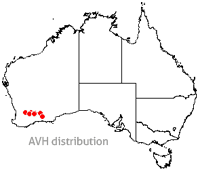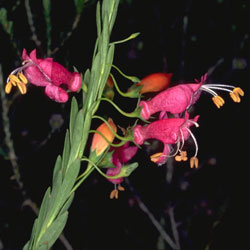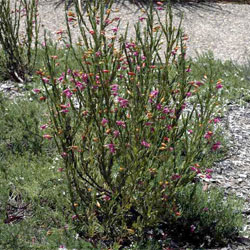Eremophila racemosa
Showy Eremophila
Eremophila racemosa (Endl.) F.Muell.
 Eremophila racemosa or Showy Eremophila is one of some 214 Eremophila species described in Australia, formerly of the Myoporaceae family, now absorbed into the Scrophulariaceae (figwort or foxglove family).
Eremophila racemosa or Showy Eremophila is one of some 214 Eremophila species described in Australia, formerly of the Myoporaceae family, now absorbed into the Scrophulariaceae (figwort or foxglove family).
E. racemosa's natural distribution is restricted to a semi-arid zone north of Ravensthorpe in the southwest of Western Australia, where the average annual rainfall is 200-400 mm. It is found around mixed Eucalyptus/Melaleuca woodlands growing on hard stony loam, sandy loam, or brown clay loam.
E. racemosa is an erect, branching shrub to 0.5-1.8m. Leaves are soft to the touch and the tubular flowers are borne on attractive S-shaped pedicels in leaf axils, Flower buds begin orange, pink, purple, reddish-purple or yellow, and bloom in various shades of pink, orange, purple and reddish-purple or white, depending on the variety. There are two main varieties; one which has yellow flower buds and white flowers, the other with multiple colours of each on the one plant. Fruit are 4-chambered, with one seed in each chamber.
Flowering is prolific and prolonged, usually beginning in late winter and lasting through to early summer. Supplementary watering during hot months to imitate summer rains will greatly extend the flowering season.
E. racemosa prefers an airy, uncrowded location and dry climate as excess moisture will encourage mould and rot. It may be short-lived in humidity. Pebbles make ideal mulch for this species by reducing humidity around the plant. It is well suited to a pot as it can be moved under cover when abundant rain or hard frost is expected, though it will tolerate moderate frost. E. racemosa enjoys well drained soils in full sun all year round. Once established, this species will tolerate extended dry spells. It should be positioned in a fairly sheltered part of the garden, as the erect branches may be easily damaged in windy conditions.
Propagation is best achieved from cuttings of current season's hardened growth, or by grafting to Myoporum insulare. This species makes the perfect root stock for E. racemosa as it will tolerate both dry and wet conditions. Suckering of the M. insulare root stock can be unsightly and removal of suckers is advised. Borers are one pest to look out for as they are known to attack M. insulare.
E. racemosa responds well to pruning. Pruning the tips after flowering will ensure masses of blooms the next year. Cutting out the tips while the plant is young will promote bushiness; however pruning of older, harder growth may be less successful.
A happy plant will give around 8-10 years of stunning displays.
Text by Jenifer French (2012 Student Botanical intern)
Name Meaning: Eremophila racemosaEremophila — f rom the Greek words eremos (meaning desert) and philos (meaning loving), hence desert-loving. racemosa — from the Latin racemus (bunch of grapes) referring to the terminal flowers of a group being the last to develop. |
References
Australian Plant Online, Association of Societies for Growing Australian Plants (2007) Research on Hedging and Coppicing. Available at http://anpsa.org.au/APOL2007/dec07-s2.html [Accessed Feb 2012].
Australian Broadcasting Commission (2002) Gardening Australia Magazine: October 2002.
Australian Native Plants Society (Australia) at http://anpsa.org.au/e-rac1.html [Accessed Feb 2012]
Boschen, N., Goods, M. & Wait, R. (2008) Australia's Eremophilas: changing gardens for a changing climate. Bloomings Books Pty Ltd, Melbourne.
Brown, A. & Buirchell, B. (2011) A field guide to the Eremophilas of Australia. Simon Nevill Publications, Australia.
Chinnock, R.J. (2007) Eremophila and allied genera: a monograph of the plant family Myoporaceae. Rosenberg Publishing Pty Ltd, New South Wales.
Howe, A. (2012) (Pers. comm.) Horticulturalist, Australian National Botanic Gardens.
Society for Growing Australian Plants (South Australian Region) (1997). Eremophilas for the garden. Soc. For Growing Aust. Plants (S.A. Region).
Western Australian Herbarium (1998-). FloraBase - The Western Australian Flora. Department of Environment and Conservation. http://florabase.dec.wa.gov.au [Accessed Feb 2012].
![An Australian Government Initiative [logo]](/images/austgovt_brown_90px.gif)



